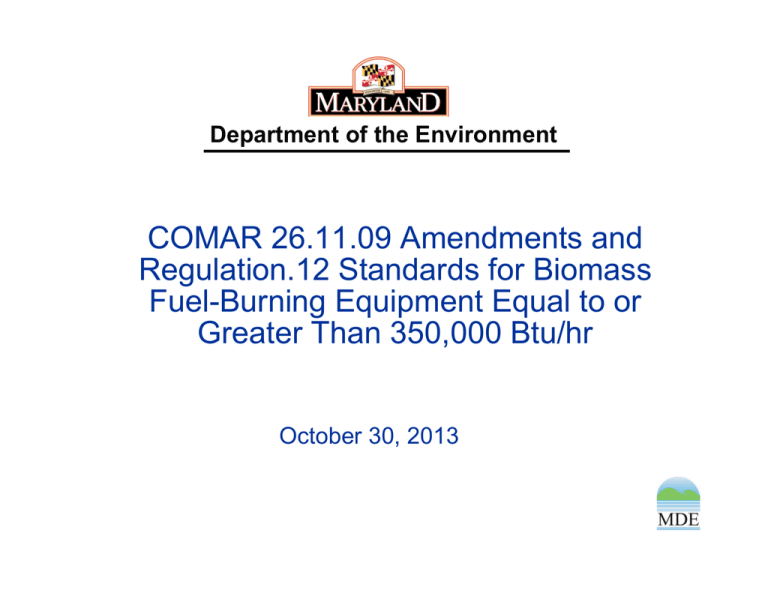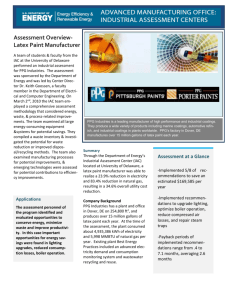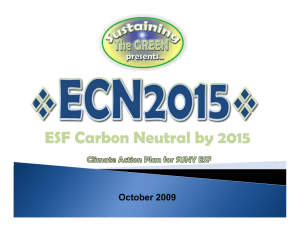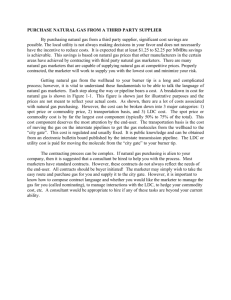COMAR 26.11.09 Amendments and Regulation.12 Standards for Biomass Greater Than 350,000 Btu/hr
advertisement

Department of the Environment COMAR 26.11.09 Amendments and Regulation.12 Standards for Biomass Fuel-Burning Equipment Equal to or Greater Than 350,000 Btu/hr October 30, 2013 Topics Covered • Standards, Technology, Costs and Amendments • MACT • Biomass boiler rates data, handling and feed rate • GACT and optimization • Cost for controls • Cost for boiler and controls • Poultry waste fuel • Affected sources • Objectives for amendments/comments • Amendments Maximum Achievable Control Technology (MACT)- Background • MACT is based on performance data – Biomass boiler is subject to standards based on size, design and emissions that are calculated from stack test results of similar boilers or established relationships of combustion test results or emission factors • Emission estimates for biomass fuel would be for PM, PM-10, PM 2.5, SO2, NOx, VOC and CO • MACT developed - PM, Hg and CO Standards Range of Biomass Boiler Rates • Boiler data from manufacturers • Leading results • PM -10 % Opacity • PM10/0.012-0.25 lb/MMBtu • SOx - 0.025 -0.035 lb/MMBtu • NOx- 0.06 – 0.255 lb/MMBtu • VOC – 0.01-0.03 lb/MMBtu • NH,CA,CT,MA,VT,NJ,PA BACT determination process Biomass Handling, Feed Rate and Monitoring • Delivery of biomass fuel • Screening for size • Storage and handling with the help of mechanized systems • Heterogeneous composition • Collection of fly ash MACT/GACT Review • Generally Available Control Technology (GACT) for boilers combusting biomass for urban HAP • Hg, arsenic, beryllium, cadmium, lead • Chromium, manganese, nickel, POM • Ethylene dioxide, and PCBs. • MACT covers PM through HAPs NSPS for Boilers • Subpart Dc-PM limit for wood units over 30MMBtu = 0.10 lb/MMBtu • Subpart Dc ICI 100 – 10 MMBtu SO2 and PM standards PM-0.05 lb/MMBtu/hr • Feb. 28, 2005 30 MMBtu/hr or greater- 0.030 lb/MMBtu/hr • Subpart Db greater than 100 MMBtu/hr PM 0.10 lb/MMBtu/hr July 9th 1997 0.2 lb/MMBtu GACT Standards • CAA allows GACT standards for area sources of HAP • GACT or management practices by area sources to reduce emissions of hazardous air pollutants. GACT Standards –Subpart JJJJJJ • New boilers with heat input capacity greater than 10 MMBtu/hr meet GACT based numerical emission limits for PM 0.07-0.03 lbs/MMBtu. • Work practice standards to minimize the boiler’s startup and shutdown periods following the manufacturer’s recommendations, or practices for a unit of similar design. Energy Assessment- Subpart JJJJJJ • Existing boilers with heat input capacity greater than 10 MMBtu/hr that are biomass-fired must have a onetime energy assessment performed. • A qualified energy assessor review by March 21, 2014, or an energy management program established through energy management systems compatible with ISO 50001 Optimization • New units, regardless of size • GACT-based biennial tune-up • Startup and shutdown established process with industry input • Notification of Compliance Status regarding the initial tuneup is reset to July 19, 2014 MACT/GACT Optimization for Less Than 10 MMBtu/hr • Technologically and economically impracticable to apply measurement methodology for small units less than 10 MMBtu/hr • HAP standards were set for larger units MD Test Results • Sources have tested and demonstrated compliance • Biomass to energy conversion with two 40 MMBtu boilers and steam turbine generators rated at 2 megawatts – Based on multi cyclone technology • PM test results 0.19-0.27 lb/MMBtu • NOx test results 0.11-0.15 lb/MMBtu Potential PM Controls • PM/PM-10: • Fabric Filter Baghouse, Wet Electrostatic Precipitators and Dry Electrostatic Precipitators. • Wet ESP’s may interfere with other controls. • The fabric filter would also not be technically feasible biomass boilers as there would be a threat of bag house fires from embers not removed in the exhaust stream. • The only potentially technically feasible option is the use of a dry ESP if costs can be reduced. Cyclone, Multi-Cyclone and ESP Cost for PM Controls • Cyclone $10,000 • Multi-Cyclone $15-25,000 • ESP • PM/PM-10: • 10 MMBtu approx 3500 acfm ---------$97,000.00 • 15 MMBtu approx 7000 acfm ---------$160,000.00 • 20 MMBtu approx 11000 acfm --------$220,000.00 • 25 MMBtu approx 14500 acfm --------$290,000.00 • 30 MMBtu approx 22500 acfm --------$340,000.00 • The operating cost (power consumption is between $ 5-20 kWhr) • Spare parts for first three years aprox. $5,000.00 Boiler, PM and NOx Control Costs Boiler Size MMBtu/hr PM Emissions Range lb/MMBtu NOx Emissions Range lb/MMBtu Capital Cost Range (From Lowest to Highest Related to Emissions) $350,000$410,000 Cost for Controls Range 2 0.2 or less 0.2-0.3 10 0.2 or less 0.2-0.3 $650,000$725,000 $15,00025,000 multicyclone 20 0.03 or less 0.2-0.3 $1-1.25 Million $220,000300,000 ESP 30 0.03 or less 0.2-0.3 $4-6 Million ESP $ 450,000$550,000 $10,00015,000 Single cyclone Operating Cost Range (From Lowest to Highest Related to Emissions) Lowest cost, uses induced draft fan which is already part of the system. Lowest cost, uses induced draft fan which is already part of the system. Higher cost vs multi-cyclone due to electrical usage of the ESP. Cost will scale up as the size of the plant increases. Higher cost vs multi-cyclone due to electrical usage of the ESP. Cost will scale up as the size of the plant increases. Poultry Waste to Energy • Is produced and used as a fuel on the farm; • Energy is recovered from the system; • Storage is protective of the environment; • Fuel value of 5,000 Btu/lb or greater, or document that energy can cost-effectively be recovered from the unit; and • Contaminants are within ranges found in traditional solid fuels. • Non Hazardous Secondary Materials (NHSM) rule includes potential precursors to air pollution such as nitrogen, sulfur, and metals) MD Existing Sources • MD has several registered equipment burning wood and one permitted for energy crops and poultry waste • Dorchester County has two wood burning boilers 24-28 MMBtu/hr • Garrett County has one 14 MMBtu/hr boiler burning sawmills • Worcester County has two boilers 6-19 MMBtu/hr burning logging wood • Somerset County has four registered units 20-40 MMBtu/hr (two at a correctional facility, rotary dryer and ethanol production) • Baltimore and Montgomery County units burn a variety of wood derived products up to 24 MMBtu/hr heat input capacity COMAR 26.11.09 Amendments • Objectives • Remove the prohibition and develop standards for wood/poultry/biomass units; • Standards and requirements based on MACT; – MD existing SIP requires strict PM standards; – Establish standards for small size units based on BACTs and review of cost effective options for PM and NOx; COMAR 26.11.09 Amendments • The draft changes to COMAR 26.11.09 -Title 26 DEPARTMENT OF THE ENVIRONMENT Subtitle 11 AIR QUALITY Chapter 09 Control of FuelBurning Equipment, Stationary Internal Combustion Engines, and Certain Fuel-Burning Installations; – .01 Definitions; – .04 Prohibition of Certain New Fuel Burning Equipment; – .06 Control of Particulate Matter; and . – .07 Control of Sulfur Oxides from Fuel Burning Equipment – Amendments pertain to the biomass fuel definition and applicability of standards to coal. COMAR 26.11.09.01 Definitions • “Biomass” – (a) Means solid organic material that can be combusted for use as fuel including the following: (i) Wood residue and wood products (e.g., trees, tree stumps, tree limbs, bark, lumber, sawdust, sander dust, chips, scraps, slabs, millings, and shavings); (ii) Animal manure, including litter and other bedding materials; (iii) Vegetative agricultural and silvicultural materials, such as logging residues (slash), nut and grain hulls and chaff (e.g., almond, walnut, peanut, rice, and wheat), bagasse, orchard prunings, corn stalks, coffee bean hulls and ground; and (iv) Any solid organic material that has been approved by the Department, on a case-by-case basis, utilizing the criteria established by EPA and set forth in 40 C.F.R.241.3, as amended. – (b) This definition of biomass is not intended to suggest that these materials are or are not solid waste. COMAR 26.11.09.04 Prohibition of Certain New Fuel Burning Equipment • COMAR 26.11.09.04 A(2) –amendment removes the prohibition for biomass fuel burning that has a rated heat input less than 13 million Btu (13.7 gigajoules) per hour heat input in Areas I, II, V and VI. • COMAR 26.11.04 B(2) amendment removes the prohibition for biomass equipment that has a rated heat input of less than 35 million Btu (37 gigajoules) per hour in Areas III and IV. The prohibitions will apply to only coal fired equipment under the proposed amendments. COMAR 26.11.09.04 Prohibition of Certain New Fuel Burning Equipment • COMAR 26.11.09.04 C(1)(b) – amendment exempts new biomass fuel-burning equipment from the prohibition process. – “New” biomass fuel-burning equipment – installed after March 1, 2014. – Permits can be issued to new biomass fuelburning equipment without an extended review and approval process. COMAR 26.11.09.04 Prohibition of Certain New Fuel Burning Equipment • For biomass fuels this procedure is no longer applicable: − There will be no violation of ambient air quality standards or Prevention of Significant Deterioration (PSD) requirements; − There will be no violation of applicable emission standards; − There is minimum potential for creation of a nuisance; and − There is reasonable assurance of fuel quality control. − The approval process involves application review, public notification in a prominent newspaper with in 10 days of approval to proceed. − Public comment period of 30 days is required. After the comment period, the Department is allowed a 60 day time period to make a final determination. − As a result of these amendments, only coal fired units would be required to go through a public review process COMAR 26.11.09.06 Control of Particulate Matter • Biomass separated from coal fuel in Areas I,II,V and VI – Higher PM emission rate – These rates are applicable to small coal fired equipment – Standards differentiated by year • Areas III and IV – Coal fired equipment is subject to a restrictive standard of 0.03 lb/MMBtu/hr – Biomass fuel burning would be subject to 0.1lb/MMBtu standard if heat input is greater than 1.5 – 10 MMBtu/hr in the draft COMAR 26.11.09.06 Control of Particulate Matter • Amendment exempts new biomass fuel-burning equipment from particulate matter requirements. • New biomass fuel-burning equipment subject to the particulate matter requirements of new Regulation .12. • Small wood boilers are subject to particulate matter requirements of Regulation .11 of this Chapter and exempt from the requirements of Regulation .06. COMAR 26.11.07 Control of Sulfur Oxides • Biomass has low sulfur content and therefore there is no significant impact • Test results show - SOx - 0.025 -0.035 lb/MMBtu COMAR 26.11.09.12 Regulation .12 Standards for Biomass Fuel-Burning Equipment Equal to or Greater Than 350,000 Btu/hr. – A. Applicability. The requirements of this regulation apply to a person who owns or operates biomass fuel-burning equipment equal to or greater than 350,000 Btu/hr heat input capacity. – B. Federal Requirements. The requirements of 40 CFR 63 Subparts DDDDD and JJJJJJ, as amended, are applicable. COMAR 26.11.09.12 Regulation C. Emission Standards for Biomass Fuel-Burning Equipment Greater Than or Equal to 10 MMBtu/hr Heat Input Capacity. – Standards – A particulate matter emission standard of 0.07 lb/MMBtu heat input if the total heat input capacity is less than 30 MMBtu/hr; – A particulate matter emission standard of 0.03 lb/MMBtu heat input if the total heat input capacity is equal to or greater than 30 MMBtu/hr; – A NOx emission standard of 0.30 lb/MMBtu heat input, if the heat input capacity is less than or equal to 250 MMBtu/hr; – A NOx emission standard of 0.25 lb/MMBtu heat input, if the heat input capacity is greater than 250 MMBtu/hr; and – An initial and biennial tune-ups. COMAR 26.11.09.12 Regulation D. Requirements for Biomass Fuel-Burning Equipment or Boilers Greater Than 1.5 MMBtu/hr and Less Than 10 MMBtu/hr Heat Input Capacity. – Standards – A particulate matter emission standard of 0.23 lb/MMBtu heat input in Areas I, II, V and VI; – A particulate matter emission standard of 0.1 lb/MMBtu heat input in Areas III and IV; – A NOx emission standard of 0.30 lb/MMBtu heat input; and – An initial and biennial tune-ups. COMAR 26.11.09.12 Regulation E. Requirements for Biomass Fuel-Burning Equipment Less Than or Equal to 1.5 MMBtu/hr and Greater than 350,000Btu/hr Heat Input Capacity. – Standards – A particulate matter emission standard of 0.35 lb/MMBtu heat input; – A NOx emission standard of 0.30 lb/MMBtu heat input; and – An initial and biennial tune-ups. COMAR 26.11.09.12 Regulation F. Existing biomass fuel-burning equipment an initial and biennial tune-ups are required to be conducted. G. A person subject to the requirements of this regulation shall operate the fuel-burning equipment in accordance with the design and maintenance specifications of the manufacturer in order to meet and maintain compliance with the applicable emission standards and performance requirements. COMAR 26.11.09.12 Regulation H. Startup and Shutdown Requirements. – A person subject to the requirements of §§C, D and E shall minimize the boiler's startup and shutdown periods following the: • Manufacturer's recommended procedures, if available; or • Recommended procedures for a unit of similar design for which manufacturer's recommended procedures are available if manufacturer's recommended procedures for the actual unit are not available. COMAR 26.11.09.12 Regulation I. Compliance. A person subject to the requirements of: – (1) §C shall demonstrate compliance with the emissions standards by following 40 CFR Part 60, Appendix A, as amended. – (2) §§D and E shall demonstrate compliance by providing certification, on a form provided by the Department, from the manufacturer that the fuel-burning equipment is designed and tested to meet the applicable particulate matter and NOx standards including a copy of test results with EPA approved test methods on fuel-burning equipment in the same model line as the new fuelburning equipment. – (3) The particulate matter emission standards of §§C, D or E of this regulation who owns or operates biomass fuel-burning equipment subject to the requirements of 40 CFR 63 Subparts DDDDD and JJJJJJ, as amended, shall: – (a) Demonstrate continuous compliance with the work practice and management practice standards as specified in 40 CFR 63; and – (b) Comply with the monitoring, installation, operation, and maintenance requirements as specified in 40 CFR 63. COMAR 26.11.09.12 Regulation J. Reporting and Recordkeeping Requirements. – (1) A person subject to the particulate matter emission standards of §§C, D or E of this regulation who owns or operates biomass fuel-burning equipment subject to the requirements of 40 CFR 63 Subparts DDDDD and JJJJJJ, as amended, shall comply with the notification, reporting, and recordkeeping requirements of 40 CFR 63. – (2) A person subject to the NOx emission standards of §C of this regulation and who owns or operates biomass fuel-burning equipment subject to the requirements of 40 CFR 63 Subparts DDDDD and JJJJJJ, as amended, shall comply with the reporting requirements of §K of Regulation .08 of this chapter. COMAR 26.11.09.12 Regulation J. Reporting and Recordkeeping Requirements. – (1) A person subject to the particulate matter emission standards of §§C, D or E of this regulation who owns or operates biomass fuel-burning equipment subject to the requirements of 40 CFR 63 Subparts DDDDD and JJJJJJ, as amended, shall comply with the notification, reporting, and recordkeeping requirements of 40 CFR 63. – (2) A person subject to the NOx emission standards of §C of this regulation and who owns or operates biomass fuel-burning equipment subject to the requirements of 40 CFR 63 Subparts DDDDD and JJJJJJ, as amended, shall comply with the reporting requirements of §K of Regulation .08 of this chapter. COMAR 26.11.09.12 Regulation J. Reporting and Recordkeeping Requirements. – (3) A person subject to the to the emission standards of §§C, D or E of this regulation who owns or operates biomass fuel-burning equipment not subject to the requirements of 40 CFR 63 Subparts DDDDD and JJJJJJ shall: – (a) Keep records for each boiler that identify: – (i) The date of tune-up operations; – (ii) The procedures followed for tune-up; – (iii) The manufacturer's specifications to which the boiler was tuned; – (iv) The occurrence and duration of each malfunction of the boiler, or of the associated air pollution control, or monitoring equipment; – (v) Actions taken during periods of malfunction to minimize emissions including corrective actions to restore the malfunctioning boiler, air pollution control, or monitoring equipment to its normal or usual manner of operation; – (b) Maintain records on site for not less than 3 years, and make these records available to the Department upon request. Maryland Department of the Environment Air & Radiation Management Administration Regulation Development Team 1800 Washington Boulevard | Baltimore, MD 21230-1718 410-537-3000 | TTY Users: 1-800-735-2258 www.mde.state.md.us




